Our bodies were almost our only energy source during most of human history. We did learn to harness the wind to drive boats, and oxen to pull loads. We learned to ride horses bareback. The Romans had water wheels, but they used them only here and there. Maybe that's because slaves did much of their work. Roughly one Roman in four was a slave.
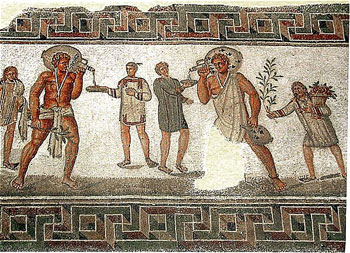
Roman fresco showing slaves serving free men [Image courtesy of Wikimedia Commons]
A society built on external power sources didn't emerge until the last millennium — roughly by the 11th century. But it all began back in the 8th century in the near wake of the Roman Empire. Western Europe was still a primitive outback when something happened that might seem small, but which had a momentous impact.
It seems to've emerged from the court of Charles Martel just after 733 AD. Someone recognized that, with the introduction of the stirrup, horses could be made into new engines of war.
Once a rider anchored his body in stirrups and was encased in a saddle with a high pommel and cantle, he and the horse became as one. A lance-carrying rider could attack with the full momentum of the horse behind his weapon.
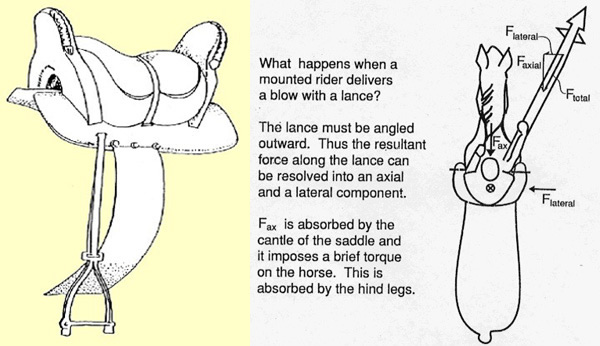
Left: medieval war saddle with stirrups and a high pommel and cantle. Right: Force balance on a mounted lancer. (Note that the lateral force would knock an unstirruped rider from his mount.) [Left-hand drawing by Maria Szigmund-Baca. Right-hand drawing and drawing below by J. H. Lienhard]
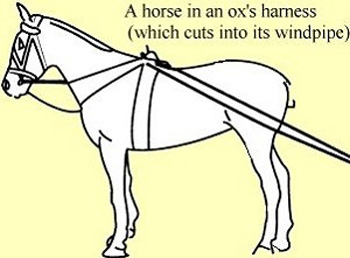 Whether or not that was the reason, the so-called Carolingian Empire (that is, the empire of the Charleses) began breeding horses on a large scale. That was when everything began changing. And the change went far beyond the occasional use of horses in war.
Whether or not that was the reason, the so-called Carolingian Empire (that is, the empire of the Charleses) began breeding horses on a large scale. That was when everything began changing. And the change went far beyond the occasional use of horses in war.
Europe could emerge as a new center of civilization only after medieval engineers developed water and wind power in ways the Romans never had. But, and here's where the horse comes in, before that could happen, European agriculture had to become productive enough to support towns with artisans, masons — a breed of people free to concentrate on new technologies.
For European agriculture to flourish, farmers needed a more powerful beast than the plodding ox to plow the heavy, wet Northern European soil. The horse had the strength and speed; but its hooves softened and fractured in damp soil.
When it was harnessed in an ox yoke, any heavy load pressed its windpipe and choked it.
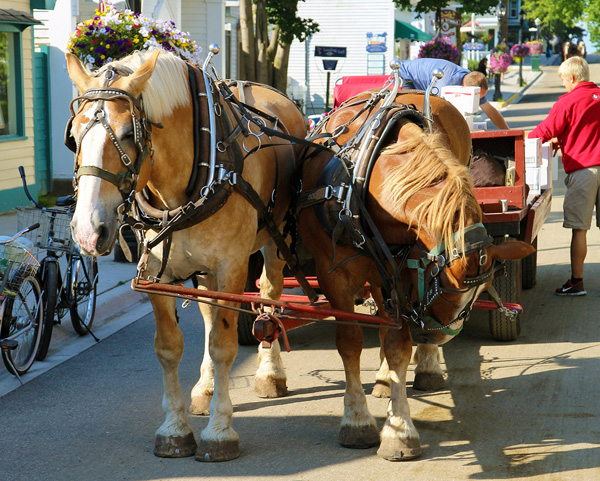
Two shod horses yoked in modern horse collars on automobile-less Mackinac Island [photo by J. H. Lienhard]
And a horse needed a better diet than an ox. It couldn't just graze grass — it also needed a source of crude protein. Now that horses were abundant, remedies followed — three inventions: First, the nailed horseshoe held hooves together in wet soil. Then the horse-collar put the load on the horse's shoulders instead of its windpipe. They were both introduced in the 9th century.
The problem of feeding horses was complex. It too was solved, but not implemented, in the 9th century. Until then farmers had used two fields. They farmed one and let the other lie idle (or fallow.) This way they kept from robbing the soil of nutrients and rendering it unproductive.
Then someone found that a field could be used two years out of three. The trick was to plant it with one crop in the fall and a different crop in the spring, a year and a half later. Farmers could break their holdings into three fields: They planted one with wheat or rye in the fall for human consumption. They planted a second in the spring to raise peas, beans, and lentils for human use, barley and oats for horses. The third field lay fallow. Each year this use rotated among the fields. Maybe you've heard an old nursery rhyme that celebrated the spring planting:
Can you or I or anyone know
How oats, peas, beans, and barley grow?
[Listen: http://www.youtube.com/watch?v=AS8hobMOPv8]
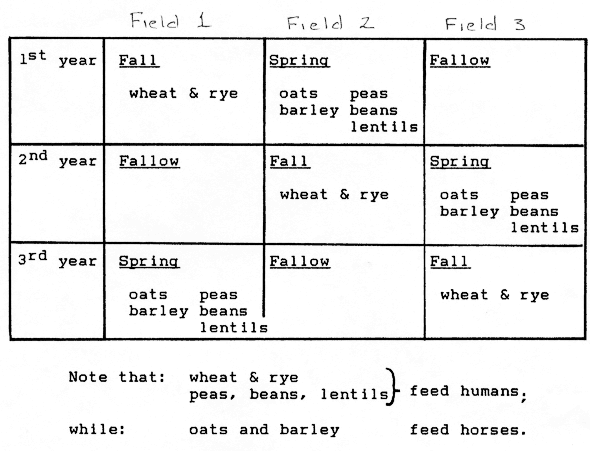
Unfortunately, this three-field crop rotation meant people had to rearrange real estate and change the social order. Effective as it was, it took 200 years to adopt. While the horseshoe and the horse collar were put to use directly, the three-field rotation scheme wasn't fully in place until the 11th century.
But adopted it finally was; and agriculture gained a whole new efficiency. With the agricultural revolution, hamlets turned into towns and cities. Artisans and intellectuals appeared. Europe saw the beginnings of civilization. Medieval craftsman, freed to develop new technologies, took up water power in a very big way.
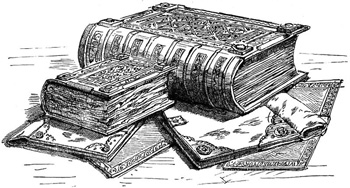
Domesday Book (Image courtesy Wikimedia Commons)
The Normans amassed their Domesday Book inventory of English people and institutions in 1086 AD. In it they recorded an amazing 5,624 operating water wheels. (And they surely must've missed even more in their count.)
Now the backbreaking labor of grinding grain, fulling wool, and sawing wood that'd been the beginning and end of most people's lives lessened. By the 11th century, so small a thing as a horseshoe had so reflected and amplified through medieval minds as to create a new civilization. But another agency arose to complete that transformation and we might find it to be a surprise. Let's look into that idea next.
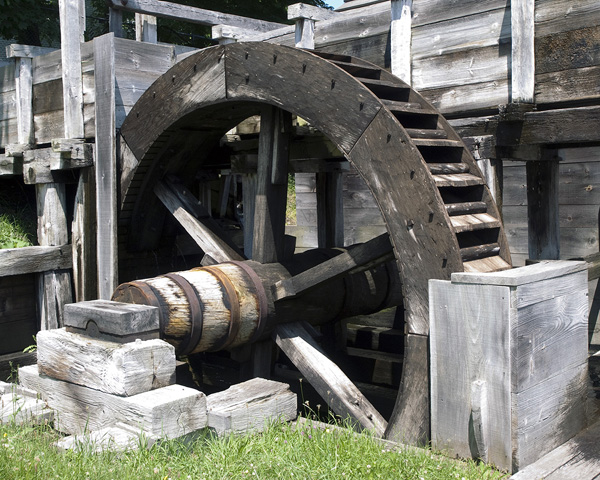
Waterwheel of the"breast type" (water enters on the left at chest height on the wheel and gravity carries it downward, rotating the wheel counter-clockwise). This is the 17th-century Saugus Iron Works, Saugus, MA, but not significantly different from medieval wheels. (Photo by J. H. Lienhard)
Sources
These ideas are articulated in far more detail by L. White, Jr., Medieval Technology and Social Change. (New York: Oxford University Press, 1966): Chapter III. White's arguments have been subjected to some criticism and revision, but I believe I've sidestepped the parts that've elicited controversy.